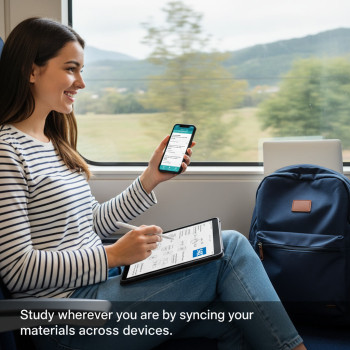Why your commute is an untapped SAT power-up
If you’re anything like most students, your commute—whether it’s 10 minutes on the bus, 30 minutes in a carpool, or an hour on public transit—feels like time that’s there but never quite useful. What if I told you that those fragments of time could be the difference between a good score and a great one? Especially with the Digital SAT’s format and adaptive sections, steady, targeted practice adds up. Small, consistent efforts can sharpen mental stamina, clarify strategies, and strengthen the kinds of thinking the test rewards.
The commute advantage
Commuting offers benefits many study blocks don’t: fewer distractions than at home, a predictable window of time, and the chance to repeat short drills on a schedule. Over a week, those short sessions compound into hours of active learning without cutting into homework or downtime. The trick is to plan with purpose: choose the right activities, use the right tools, and rotate focus so your brain keeps building different skills.
How to design a commute-friendly SAT routine
Don’t try to cram a full practice test into a 20-minute bus ride. Instead, break your prep into bite-sized, purposeful tasks. Here’s a simple framework you can adapt to any commute length.
- 5–10 minutes: Warm-up + review flashcards or vocabulary in context.
- 10–25 minutes: Focused skill work (grammar rules, reading strategies, or math concept review).
- 25–45 minutes: Mixed practice—timed sections, paired-question drills, or explanation-focused review of problems you missed earlier.
- 45+ minutes: Simulated sections or longer review sessions that combine explanation, annotation, and active recall.
Rotate these each day so you strengthen different parts of the test without burnout. If you have several short commutes per day, use one for concept-building (math rules or grammar patterns) and another for mentally lighter tasks (audio reading practice or reviewing mistakes).
Set a weekly micro-plan
Here’s a simple schedule you can follow and tweak:
- Monday: Reading strategy + one timed passage (commute there) and review explanations (commute back).
- Tuesday: Math concept focus (algebra or data analysis) with 10 targeted problem drills.
- Wednesday: Writing & Language rules—punctuation and sentence logic flashcards.
- Thursday: Vocabulary-in-context and active reading (listen to passages aloud; summarize mentally).
- Friday: Targeted review—go over mistakes from earlier in the week and practice spaced repetition.
- Weekend: Longer practice or a simulated digital section (on the Bluebook app or official practice platform) to consolidate.
Tools and formats that fit commute life
Digital SAT prep is friendlier to commuting students than ever before. That’s because audio, mobile-friendly practice, and quick-check resources let you learn while your eyes aren’t on a page. But choose the right formats to match your environment and safety (never try to read small text while walking or driving).
Audio practice
Listening to passages, explanations, or concept reviews is a perfect commute activity. Convert reading passages into audio (many official practice resources and study partners provide audio versions), or listen to tutors explain reasoning behind math problems. Active listening—pausing mentally to summarize or predict—turns passive time into focused study.
Micro-lessons and flashcards
Use flashcard apps for grammar rules, math formulas, and vocabulary-in-context prompts. Keep each card to one idea. In ten minutes you can review 20–30 cards. For best results, use spaced repetition so you re-encounter weak points at strategic intervals.
Bluebook and official digital practice
Practice on the same type of interface you’ll use on test day. For long commutes where you can safely use a device, schedule full sections on the official digital interface during weekend trips or supervised practice sessions. During short commutes, use the official materials for quick quizzes or to review diagnostic feedback later.
Commute-friendly SAT drills, by section
Each SAT section favors different strategies. Here’s how to convert commute minutes into meaningful gains for Reading, Writing & Language, and Math.
Reading
- Audio passage + 1 main idea summary: Listen to a passage (or read aloud a paragraph) and mentally summarize the thesis in one sentence. This trains comprehension speed and retention.
- Passage-mapping in 2–3 bullets: On a short notepad, jot the role of each paragraph (e.g., claim, evidence, counter). You’ll get faster at spotting structure and author tone.
- Question-type recognition: Each commute, pick a question type—main idea, inference, meaning-in-context—and practice recognizing cues and trap options.
Writing & Language
- Rule-of-the-day: Pick one grammar or punctuation rule (comma usage, parallel structure). Identify it in example sentences during your commute.
- Mini-edit drills: Practice choosing the clearest phrasing for short sentences. This helps you internalize concision and clarity on the go.
Math
- Concept audio explanations: For algebraic manipulations, listen to short audio walk-throughs of the steps and visualize each transformation.
- Problem setup practice: While commuting, describe how you’d set up a problem—what variable you’d define and which equation you’d use—without computing the entire solution. This builds mathematical intuition and reduces calculation errors under time pressure.
Sample commute session templates
Below are ready-to-use templates for different commute lengths. Pick one and customize it to your test date and weak spots.
| Commute Length | Warm-up (5 min) | Main Activity (10–25 min) | Wrap (5 min) |
|---|---|---|---|
| 10 minutes | Flashcards (grammar or vocab) | One reading passage audio summary | Quick review: one mistake from yesterday |
| 20 minutes | Rule-of-the-day (writing) | Two short math setup problems (no heavy calc) | One-sentence reflection: what improved? |
| 45 minutes | 5-minute recap of last full practice | Timed digital reading section or 15–20 mixed questions | Log mistakes + plan one correction |
Keep it safe and sustainable
Studying during the commute is brilliant—if you do it safely and without burning out. Here are practical rules to keep you healthy and consistent.
- Safety first: If you’re the driver, use audio-only activities. If walking, keep your head up and stick to flashcards or audio summaries.
- Rest matters: Use commute studying as an add-on, not a replacement for longer practice sessions and sleep. Cognitive gains need recovery time.
- Keep variety: Rotate activities so you don’t plateau or dread the routine. New formats keep your brain engaged.
When to avoid commuting study
If your commute is chaotic—frequent interruptions, loud noise, or intense motion sickness—save focused work for quieter times. But brief reviews, motivational listening, or mental problem setup practice still work in noisy settings.
Tracking progress: simple metrics that work
It’s easy to do commute studies and never notice real improvement. Use compact, measurable trackers to keep momentum and to know where to change course.
- Weekly minutes: Aim for a realistic target (e.g., 150–300 minutes/week). Track total time and the split across Reading/Writing/Math.
- Error categories: For every commute drill that finds a mistake, tag it (e.g., carelessness, concept gap, time pressure). If one tag dominates, adjust your study plan.
- Active recall check: End your week by trying to explain one difficult concept aloud without notes. If you struggle, schedule a deeper commute session focused on that topic.
Examples: commute transformation stories
Here are two condensed, realistic examples of how students turned small commute routines into measurable gains.
Case study: Maya — the 25-minute bus rider
Maya had a 25-minute ride each way. She used mornings for audio passages and one-sentence mapping and evenings for flashcards and math setups. Over six weeks she moved from frequently missing inference questions to confidently mapping author purpose and eliminating careless errors. Her weekly plan added up to about six hours of focused prep outside of homework.
Case study: Jordan — the carpool power user
Jordan couldn’t use a screen while commuting, so he recorded himself explaining problem setups and played them back. He also practiced mental math transformations and grammar rule recitations. Those sessions made him faster at recognizing what a question was asking on the test and reduced his time per math question by about 15–20% during practice sections.
How to combine commute work with guided tutoring
Independent practice is powerful, but targeted guidance accelerates results. Personalized tutoring—especially 1-on-1—helps identify weak patterns earlier and gives you tailored techniques you can practice during commutes. For many students, working with an expert who can assign commute-perfect drills (short audio explanations, micro-lessons, and curated flashcard sets) makes the difference between busywork and deliberate practice.
If you’re curious, Sparkl’s personalized tutoring offers 1-on-1 guidance, tailored study plans, expert tutors, and AI-driven insights that can slot commute sessions into your overall plan. A tutor can review commute logs, point out recurring mistake patterns, and assign precise micro-practice that reinforces what you learn in full practice sessions.
Practical tips to get started today
- Create a commute kit: One pair of earbuds, a small notebook, one pen, a phone or small tablet, and a flashcard app. Keep it ready so you don’t waste the first five minutes fumbling.
- Schedule the habit: Put a 10–20 minute commute session on your calendar as you would a class. Treat it like a non-negotiable appointment.
- Mirror test conditions sometimes: At least once every week or two, simulate timed sections on the digital interface so you don’t get surprised by the adaptive format.
- Mix active and passive: Alternate active problem-solving with passive listening to explanations. Both are valuable; the former builds technical skill, the latter builds intuition and comprehension.
What to keep in a commute mistake log
A single line per mistake is enough: date, question type, why you missed it, and one action to fix it. Over time those lines reveal trends you can fix efficiently.
Common commuter study problems — and how to fix them
Every strategy has friction. Here are common issues and quick fixes.
- Problem: Distracted by friends or music. Fix: Use noise-cancelling earbuds and choose early or late rides when it’s quieter, or do review during one direction only.
- Problem: Running out of battery. Fix: Carry a small power bank and an offline set of audio files or flashcards.
- Problem: Repeating the same weak activity. Fix: Use a weekly rotation; ask a tutor or use AI-driven diagnostics to vary the focus.
Measuring real impact: when commute practice pays off
You’ll know your commute strategy is working when these signs appear:
- You spend less time on questions you used to overthink.
- Your mistake log shows fewer concept gaps and more random slip-ups—an indicator of refined fundamentals.
- Your timed practice sections show steadily improving pacing without a rise in errors.
Tracking these wins matters more than obsessing over day-to-day score swings. Small, consistent improvements compound into meaningful score gains over weeks and months.
Starter checklist: the first week of commute-powered prep
Follow this checklist during your first seven days and then reassess.
- Assemble your commute kit.
- Pick one rule-of-the-day for Writing & Language.
- Commit to an audio-reading passage each morning or afternoon commute.
- Create a three-line mistake log and add to it immediately after each session.
- Schedule one weekend practice on the official digital interface.
Final thoughts: consistency beats intensity
Turning commute time into SAT prep is less about radical study marathons and more about steady, intentional practice. The Digital SAT rewards clarity of thought, strategic reading, and the ability to apply rules quickly—skills that grow from repetition and reflection, not last-minute cramming. By transforming your daily travel into structured, measurable learning, you’ll build momentum without sacrificing balance.
And remember: guided help makes your commute minutes more effective. If you want tailored micro-plans for each commute length, one-on-one feedback on your mistake log, or AI-backed plans that adapt as you improve, consider pairing your commute strategy with personalized tutoring. With the right plan, those everyday minutes become the most productive part of your study week.
Start small, stay consistent, and let the commute do the heavy lifting. Good luck—you’ve already got the time; now make it count.












No Comments
Leave a comment Cancel